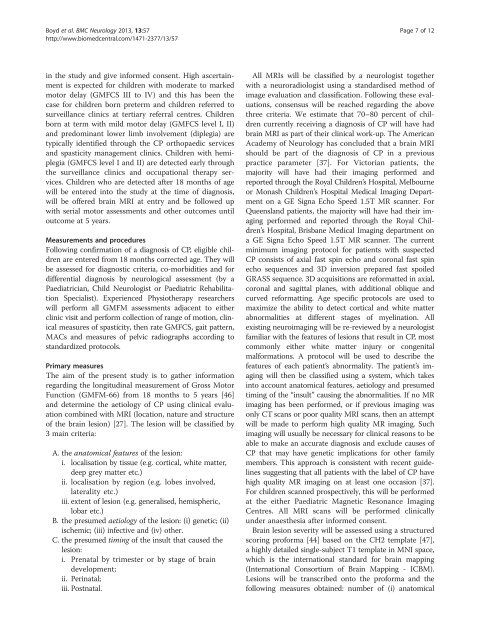Australian Cerebral Palsy Child Study: protocol of ... - BioMed Central
Australian Cerebral Palsy Child Study: protocol of ... - BioMed Central
Australian Cerebral Palsy Child Study: protocol of ... - BioMed Central
You also want an ePaper? Increase the reach of your titles
YUMPU automatically turns print PDFs into web optimized ePapers that Google loves.
Boyd et al. BMC Neurology 2013, 13:57 Page 7 <strong>of</strong> 12<br />
http://www.biomedcentral.com/1471-2377/13/57<br />
in the study and give informed consent. High ascertainment<br />
is expected for children with moderate to marked<br />
motor delay (GMFCS III to IV) and this has been the<br />
case for children born preterm and children referred to<br />
surveillance clinics at tertiary referral centres. <strong>Child</strong>ren<br />
born at term with mild motor delay (GMFCS level I, II)<br />
and predominant lower limb involvement (diplegia) are<br />
typically identified through the CP orthopaedic services<br />
and spasticity management clinics. <strong>Child</strong>ren with hemiplegia<br />
(GMFCS level I and II) are detected early through<br />
the surveillance clinics and occupational therapy services.<br />
<strong>Child</strong>ren who are detected after 18 months <strong>of</strong> age<br />
will be entered into the study at the time <strong>of</strong> diagnosis,<br />
will be <strong>of</strong>fered brain MRI at entry and be followed up<br />
with serial motor assessments and other outcomes until<br />
outcome at 5 years.<br />
Measurements and procedures<br />
Following confirmation <strong>of</strong> a diagnosis <strong>of</strong> CP, eligible children<br />
are entered from 18 months corrected age. They will<br />
be assessed for diagnostic criteria, co-morbidities and for<br />
differential diagnosis by neurological assessment (by a<br />
Paediatrician, <strong>Child</strong> Neurologist or Paediatric Rehabilitation<br />
Specialist). Experienced Physiotherapy researchers<br />
will perform all GMFM assessments adjacent to either<br />
clinic visit and perform collection <strong>of</strong> range <strong>of</strong> motion, clinical<br />
measures <strong>of</strong> spasticity, then rate GMFCS, gait pattern,<br />
MACs and measures <strong>of</strong> pelvic radiographs according to<br />
standardized <strong>protocol</strong>s.<br />
Primary measures<br />
The aim <strong>of</strong> the present study is to gather information<br />
regarding the longitudinal measurement <strong>of</strong> Gross Motor<br />
Function (GMFM-66) from 18 months to 5 years [46]<br />
and determine the aetiology <strong>of</strong> CP using clinical evaluation<br />
combined with MRI (location, nature and structure<br />
<strong>of</strong> the brain lesion) [27]. The lesion will be classified by<br />
3 main criteria:<br />
A. the anatomical features <strong>of</strong> the lesion:<br />
i. localisation by tissue (e.g. cortical, white matter,<br />
deep grey matter etc.)<br />
ii. localisation by region (e.g. lobes involved,<br />
laterality etc.)<br />
iii. extent <strong>of</strong> lesion (e.g. generalised, hemispheric,<br />
lobar etc.)<br />
B. the presumed aetiology <strong>of</strong> the lesion: (i) genetic; (ii)<br />
ischemic; (iii) infective and (iv) other.<br />
C. the presumed timing <strong>of</strong> the insult that caused the<br />
lesion:<br />
i. Prenatal by trimester or by stage <strong>of</strong> brain<br />
development;<br />
ii. Perinatal;<br />
iii. Postnatal.<br />
All MRIs will be classified by a neurologist together<br />
with a neuroradiologist using a standardised method <strong>of</strong><br />
image evaluation and classification. Following these evaluations,<br />
consensus will be reached regarding the above<br />
three criteria. We estimate that 70–80 percent <strong>of</strong> children<br />
currently receiving a diagnosis <strong>of</strong> CP will have had<br />
brain MRI as part <strong>of</strong> their clinical work-up. The American<br />
Academy <strong>of</strong> Neurology has concluded that a brain MRI<br />
should be part <strong>of</strong> the diagnosis <strong>of</strong> CP in a previous<br />
practice parameter [37]. For Victorian patients, the<br />
majority will have had their imaging performed and<br />
reported through the Royal <strong>Child</strong>ren’s Hospital, Melbourne<br />
or Monash <strong>Child</strong>ren’s Hospital Medical Imaging Department<br />
on a GE Signa Echo Speed 1.5T MR scanner. For<br />
Queensland patients, the majority will have had their imaging<br />
performed and reported through the Royal <strong>Child</strong>ren’s<br />
Hospital, Brisbane Medical Imaging department on<br />
a GE Signa Echo Speed 1.5T MR scanner. The current<br />
minimum imaging <strong>protocol</strong> for patients with suspected<br />
CP consists <strong>of</strong> axial fast spin echo and coronal fast spin<br />
echo sequences and 3D inversion prepared fast spoiled<br />
GRASS sequence. 3D acquisitions are reformatted in axial,<br />
coronal and sagittal planes, with additional oblique and<br />
curved reformatting. Age specific <strong>protocol</strong>s are used to<br />
maximize the ability to detect cortical and white matter<br />
abnormalities at different stages <strong>of</strong> myelination. All<br />
existing neuroimaging will be re-reviewed by a neurologist<br />
familiar with the features <strong>of</strong> lesions that result in CP, most<br />
commonly either white matter injury or congenital<br />
malformations. A <strong>protocol</strong> will be used to describe the<br />
features <strong>of</strong> each patient’s abnormality. The patient’s imaging<br />
will then be classified using a system, which takes<br />
into account anatomical features, aetiology and presumed<br />
timing <strong>of</strong> the “insult” causing the abnormalities. If no MR<br />
imaging has been performed, or if previous imaging was<br />
only CT scans or poor quality MRI scans, then an attempt<br />
will be made to perform high quality MR imaging. Such<br />
imaging will usually be necessary for clinical reasons to be<br />
able to make an accurate diagnosis and exclude causes <strong>of</strong><br />
CP that may have genetic implications for other family<br />
members. This approach is consistent with recent guidelines<br />
suggesting that all patients with the label <strong>of</strong> CP have<br />
high quality MR imaging on at least one occasion [37].<br />
For children scanned prospectively, this will be performed<br />
at the either Paediatric Magnetic Resonance Imaging<br />
Centres. All MRI scans will be performed clinically<br />
under anaesthesia after informed consent.<br />
Brain lesion severity will be assessed using a structured<br />
scoring pr<strong>of</strong>orma [44] based on the CH2 template [47],<br />
a highly detailed single-subject T1 template in MNI space,<br />
which is the international standard for brain mapping<br />
(International Consortium <strong>of</strong> Brain Mapping - ICBM).<br />
Lesions will be transcribed onto the pr<strong>of</strong>orma and the<br />
following measures obtained: number <strong>of</strong> (i) anatomical
















